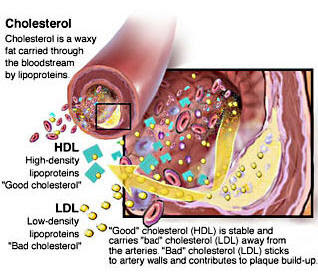By Diane Forrest, RN
September is Cholesterol Education Month. Facts about cholesterol can be somewhat confusing. First of all...what exactly is cholesterol? Cholesterol is a waxy, fat-like substance that occurs naturally in all parts of the body. Your body needs some cholesterol to work properly. But if you have too much in your blood, it can stick to the walls of your arteries. This is called plaque. Plaque can narrow your arteries or even block them.
While nearly 75% of the body's cholesterol is produced by the body, the rest comes from foods we eat. Some foods that are high in cholesterol include:
Cheese
Egg Yolks
Pork
Poultry
Shrimp
Beef
Human Breast Milk.
There are two types of cholesterol: "good" and "bad." It's important to understand the difference, and to know the levels of "good" and "bad" cholesterol in your blood. Too much of one type — or not enough of another — can put you at risk for coronary heart disease, heart attack or stroke. A cholesterol screening measures your level of HDL and LDL. HDL is the "good" cholesterol which helps keep the LDL (bad) cholesterol from getting lodged into your artery walls. A healthy level of HDL may also protect against heart attack and stroke, while low levels of HDL (less than 40 mg/dL for men and less than 50 mg/dL for women) have been shown to increase the risk of heart disease.
LDL cholesterol is the "bad" cholesterol. When too much of it circulates in the blood, it can clog arteries, increasing your risk of heart attack and stroke.
Dietary Guidelines:
The American Heart Association's Nutrition Committee strongly advises these fat guidelines for healthy Americans over age 2:
- Limit total fat intake to less than 25–35 percent of your total calories each day;
- Limit saturated fat intake to less than 7 percent of total daily calories;
- Limit trans fat intake to less than 1 percent of total daily calories;
- The remaining fat should come from sources of monounsaturated and polyunsaturated fats such as nuts, seeds, fish and vegetable oils; and
- Limit cholesterol intake to less than 300 mg per day, for most people. If you have coronary heart disease or your LDL cholesterol level is 100 mg/dL or greater, limit your cholesterol intake to less than 200 milligrams a day.
For example, a sedentary female who is 31–50 years old needs about 2,000 calories each day. Therefore, she should consume less than 16 g saturated fat, less than 2 g trans-fat and between 50 and 70 grams of total fat each day (with most fats coming from sources of polyunsaturated and monounsaturated fats, such as fish, nuts, seeds and vegetable oils).
Diagnosing and Treating
High cholesterol has no symptoms. To determine if your cholesterol level is high, all you need is a routine blood test. If you have a family history of heart disease, it is advisable to have this checked once or twice a year. Treating high cholesterol can be as simple as a change in your lifestyle. Monitoring your fat intake along with exercise may be enough to keep the LDL's down. Sometimes your doctor may prescribe medication to help lower your cholesterol level.
My cousin's husband has a family history of cardiac problems. He is in his mid-40's and recently had his blood checked to determine his levels. It was discovered that his levels were high, and he immediately began to change his eating habits. He started eating more vegetables, grilled or broiled fish and chicken, and exercising more. He now has lowered his level, lost weight, feels better and reduced his chances of heart disease.
For more information about Cholesterol visit this site:
http://heart.org/HEARTORG/Conditions/Cholesterol/Cholesterol_UCM_001089_SubHomePage.jsp







No comments:
Post a Comment